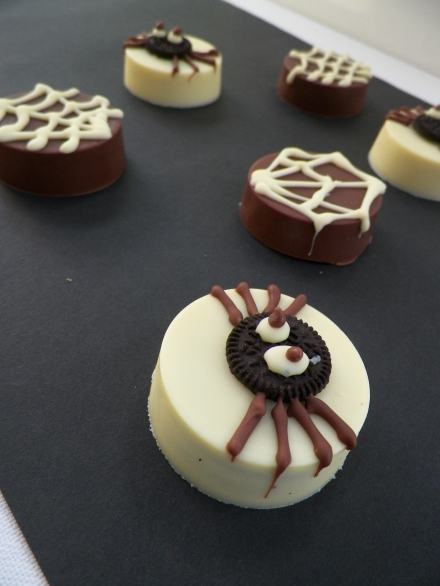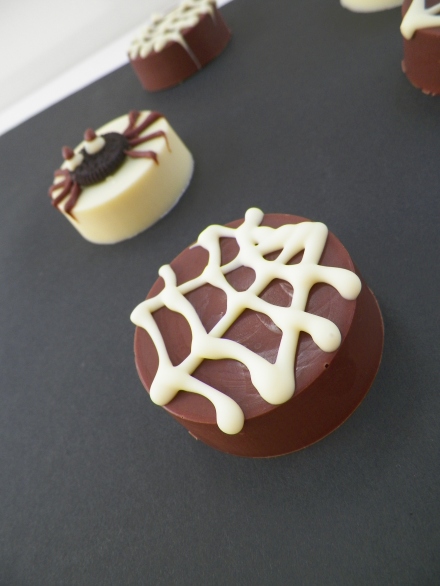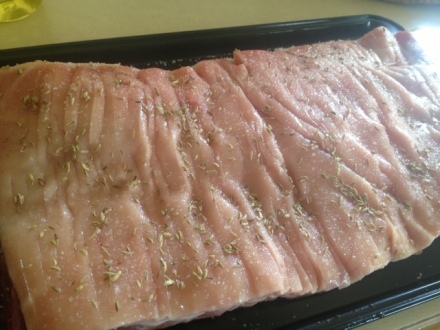After four months of no baking, it feels good to be back! I can’t believe it’s been THAT long, nearly half a year of no butter and sugar action, which is a just a bit wrong, really. When I stepped back into the kitchen and begun measuring my ingredients out, it all came flooding back. It was reassuring to know that I hadn’t completely lost my touch, and the macaron recipe I use has remained engraved in my brain – it’s the only recipe I know off by heart, no surprise. I had been planning these macarons for about a week to mark the beginning of my Christmas baking schedule, which is very hectic – again, no surprise, as I always become over ambitious with these things, trying to do waaaaay too much in so little time. Whilst this flavour is not quintessentially Christmass-y, it is extremely delicious. Anything involving salted caramel is. I poached the pears in vanilla and cinnamon, so I guess that means I can claim it as a Christmas flavour?

I loved the fresh hit of the pear in the midst of the creamy caramel, however I think it made the shells bit soggy unfortunately. Next time, I would maybe try making my own pear jelly and have little cubes in the middle. They were delicious nonetheless. The green Christmas trees on the shells were incidental actually. I just thought it would be nice to add a little green touch to represent the pear, but I’m happy with the result!

Macarons:
This recipe is Adriano Zumbo’s, and was published a couple of years ago in the Herald Sun. You will definitely need kitchen scales to make macarons.
- 135g almond meal
- 135g icing sugar
- 125g caster sugar
- 45g egg whites
- 50g egg whites
- 40g water
- Colouring gel, green
Spray four oven trays with cooking oil spray around the edges, and line with baking paper and set aside. Place almond meal and icing sugar in a large bowl, and sift together 3 times. Set aside, along with the 45g egg whites. Put 50g egg whites in a separate bowl. Heat caster sugar and water in a small saucepan, over a low-medium heat, until the sugar completely dissolves (if it slightly burns my tongue, it’s done!). If you do not want to burn your tongue, Zumbo suggests investing in a candy thermometer and heating the syrup until it reaches 118 degrees C (244 degrees F). If the syrup becomes thick and powdery in appearance, you will need to start again. This is because the sugar has been heated too much, too quickly, and instead of dissolving, it has cooked.
Begin beating the 50g egg whites with one hand, and with the other, stream the hot sugar syrup down the side of the bowl to create an italian meringue. Beat until stiff peaks form, the meringue should be thick and very glossy. If you want to add flavouring/colouring, now’s your moment. So add the colouring now. Just lightly beat them into the meringue. Pour meringue into the almond meal, icing sugar and 45g egg whites mixture and mix roughly to combine. When combined, fold mixture together (one single stroke) until there are no air bubbles left. Make a spread across the top of the mixture, and it should disappear in about 20 seconds. Spoon mixture into a piping bag fitted with a round nozzle. (If you don’t have a piping bag set, most supermarkets sell plastic ones, they are Multix brand, in an orange box and contain 5 piping bags with a few different nozzles, plus they’re only about $3. You should be able to find them in the baking aisle). Dip a skewer into green colouring gel, and wipe up one side of the piping bag, creating a straight line. Lock the bag by spinning the top around 4 times. Pipe 3-4cm rounds on the oven trays prepared earlier. Tap the bottom of the trays on the kitchen bench and let them sit for about half an hour, or until mixture is dry to the touch. Meanwhile, preheat the oven to 145c (135c fan forced).
Place in oven and bake for 16-20 minutes. Check macarons at 16 minutes, and to test if they are cooked, pull a macaron off the baking paper. If it is stuck, keep cooking and checking regularly. Cool on trays for 5 minutes, then peel off and place on a wire rack. The mixture should make about 12 -15 large macarons, and about 25 smaller macarons. Macarons keep really well (about 5 days in the fridge) and some say that the longer they are refrigerated, the more the flavour is likely to develop. Macarons taste best when they are stored in the fridge, then brought down to room temperature to eat.

Caramel Maison: (from p. 242 of Adriano Zumbo’s book, Zumbo):
•220g pouring (whipping) cream (35% fat)
•1 vanilla bean, split and seeds scraped (I used 1 tsp vanilla bean paste)
•120g water (this is just under 1 cup)
•300g caster (white) sugar
•60g liquid glucose (available at most supermarkets)
Place the cream and vanilla in a small saucepan over a medium heat and bring to the boil. Then, remove from the heat, and remove the vanilla bean if you are using one. In the meantime, place the water, sugar and glucose in a larger saucepan over a low-medium heat and cook until the glucose and sugar are fully dissolved, stirring occasionally. Zumbo’s says to use a clean pastry brush dipped in water to clean the sides of the saucepan in order to avoid crystalisation, however you can also just place the saucepan in really hot water with suds just after use and the sugar will melt off really easily. Increase the heat to medium, and cook the sugar mixture until it reaches a dark amber colour. This does take quite a while, and I was getting worried that mine would not work, but persistence is key here, it will eventually darken after 6-7 minutes. Very carefully stir the cream mixture into the sugar mixture slowly – be very careful because it spits and releases lot of heat. I found the best way to do this was with a spoon with a very long handle, as you want to keep your face as far away from the saucepan whilst it is spitting. If you don’t have a spoon with a super long handle, just add the cream really slowly and try to stir as best you can! Keep stirring as much as you can until the caramel settles down, then stir until completely smooth. Transfer to a bowl, let it cool to room temperature, cover with plastic wrap and place in the fridge.
Caramel Buttercream: (this recipe is on page 42 of Zumbo’s cookbook)
•150g unsalted butter, chopped and softened
•300g caramel maison
•4.5g sea salt flakes
Place the butter in a bowl, and beat until light and fluffy. Warm the caramel maison in the microwave until it reaches a pouring consistency (mine needed 1 min, 20 seconds on high as it was in the fridge overnight), however, just warm it in stages to prevent burning the caramel. With the beater running slowly, add the caramel maison to the butter and continue mixing until thick. Once I had added about half of my caramel, I got a bit worried because it looked like it was curdling, however as I kept adding the caramel, it began to thicken up. So don’t freak out until you have added all of the caramel to the butter. Once you have added all of the caramel, fold in the salt. I did not measure my salt, as I used a shaker. So if you too are using a shaker, just salt to taste.

Poached Pears: (recipe adapted from Taste.com.au)
- 2 packham pears
- 3 cups cold water
- 1 cup caster (white) sugar
- ½ teaspoon vanilla bean paste or ½ vanilla bean with seeds scraped
- 1 cinnamon stick
- Lemon juice
Peel pears from the stem down, and coat in lemon juice. Place all ingredients in a medium sized saucepan and simmer over a medium heat for around 20 minutes, or until pear is soft. You can test the pear with a fork, however do not make too many holes as they can become waterlogged. Once pear is cooked through, place in fridge for approximately 30 minutes to cool completely. Once cooled, cut into small bite sized pieces.
Assembly:
Pair up likely macaron shells. Scoop caramel into a piping bag fitted with a round nozzle. Pipe a small circle on one shell, place a piece of pear on the caramel, and pipe another small circle over the top of the pear. Sandwich together, and place in an airtight container in the fridge. When ready to eat, bring macarons down to room temperature.





















